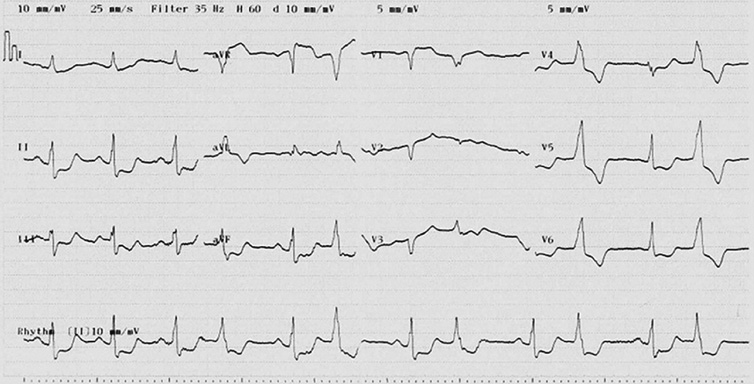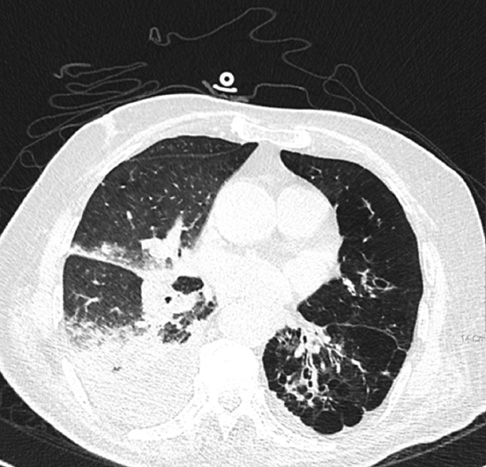J Korean Med Sci.
2012 Feb;27(2):211-214. 10.3346/jkms.2012.27.2.211.
Unilateral Pulmonary Edema: A Rare Initial Presentation of Cardiogenic Shock due to Acute Myocardial Infarction
- Affiliations
-
- 1Division of Cardiology, Hanyang University Guri Hospital, Guri, Korea. leeju@hanyang.ac.kr
- 2Division of Cardiology, Hanyang University Seoul Hospital, Seoul, Korea.
- 3Division of Cardiology, St. Luke's Roosevelt Hospital, New York, NY, USA.
- KMID: 1120161
- DOI: http://doi.org/10.3346/jkms.2012.27.2.211
Abstract
- Cardiogenic unilateral pulmonary edema (UPE) is a rare clinical entity that is often misdiagnosed at first. Most cases of cardiogenic UPE occur in the right upper lobe and are caused by severe mitral regurgitation (MR). We present an unusual case of right-sided UPE in a patient with cardiogenic shock due to acute myocardial infarction (AMI) without severe MR. The patient was successfully treated by percutaneous coronary intervention and medical therapy for heart failure. Follow-up chest Radiography showed complete resolution of the UPE. This case reminds us that AMI can present as UPE even in patients without severe MR or any preexisting pulmonary disease affecting the vasculature or parenchyma of the lung.
Keyword
MeSH Terms
-
Acute Disease
Aged
Coronary Angiography
Diagnosis, Differential
Heart Atria/ultrasonography
Heart Failure/diagnosis/etiology
Humans
Male
Mitral Valve Insufficiency/ultrasonography
Myocardial Infarction/complications/*diagnosis/therapy
Pulmonary Edema/*diagnosis/etiology/therapy
Shock, Cardiogenic/*diagnosis/etiology/therapy
Tomography, X-Ray Computed
Figure
Reference
-
1. Attias D, Mansencal N, Auvert B, Vieillard-Baron A, Delos A, Lacombe P, N'Guetta R, Jardin F, Dubourg O. Prevalence, characteristics, and outcomes of patients presenting with cardiogenic unilateral pulmonary edema. Circulation. 2010. 122:1109–1115.2. Peña C, Jaquet M, Salgado J, Pubul V, Ruibal A, Vázquez B. Asymmetric pulmonary perfusion causing unilateral pulmonary edema as a complication of acute myocardial infarction. Rev Esp Cardiol. 2005. 58:875–877.3. Pena-Gil C, Figueras J, Soler-Soler J. Acute cardiogenic pulmonary edema: relevance of multivessel disease, conduction abnormalities and silent ischemia. Int J Cardiol. 2005. 103:59–66.4. Agarwal R, Aggarwal AN, Gupta D. Other causes of unilateral pulmonary edema. Am J Emerg Med. 2007. 25:129–131.5. Akiyama K, Suetsugu F, Hidai T, Shimamoto K, Takahashi S. Left-sided unilateral pulmonary edema in postinfarction ventricular septal rupture. Chest. 1994. 105:1264–1265.6. Schnyder PA, Sarraj AM, Duvoisin BE, Kapenberger L, Landry MJ. Pulmonary edema associated with mitral regurgitation: prevalence of predominant involvement of the right upper lobe. AJR Am J Roentgenol. 1993. 161:33–36.7. Birnbaum Y, Chamoun AJ, Conti VR, Uretsky BF. Mitral regurgitation following acute myocardial infarction. Coron Artery Dis. 2002. 13:337–344.8. Kyne L, Hausdorff JM, Knight E, Dukas L, Azhar G, Wei JY. Neutrophilia and congestive heart failure after acute myocardial infarction. Am Heart J. 2000. 139:94–100.9. Haeusler KG, Schmidt WU, Foehring F, Meisel C, Guenther C, Brunecker P, Kunze C, Helms T, Dirnagl U, Volk HD, Villringer A. Immune responses after acute ischemic stroke or myocardial infarction. Int J Cardiol. 2010. 10.1016/j.ijcard.2010.10.053.10. D'Aloia A, Faggiano P, Brentana L, Boldini A, Procopio R, Racheli M, Dei Cas L. A difficult diagnosis: right unilateral cardiogenic pulmonary edema. Usefulness of biochemical markers of heart failure for the correct diagnosis. Ital Heart J. 2005. 6:771–774.11. Desjardins VA, Enriquez-Sarano M, Tajik AJ, Bailey KR, Seward JB. Intensity of murmurs correlates with severity of valvular regurgitation. Am J Med. 1996. 100:149–156.12. Piérard LA, Lancellotti P. The role of ischemic mitral regurgitation in the pathogenesis of acute pulmonary edema. N Engl J Med. 2004. 351:1627–1634.13. Raijmakers PG, Bax JJ, Groeneveld AB, Visser FC, Teule GJ, Thijs LG. What is the cause of pulmonary oedema after acute myocardial infarction? A case study. Intensive Care Med. 1996. 22:591–592.
- Full Text Links
- Actions
-
Cited
- CITED
-
- Close
- Share
- Similar articles
-
- Acute Myocardial Infarction with Cardiogenic Shock in a Young Adult with Minimal Change Disease
- Does arterial hypotension due to cardiogenic shock in older patients lead to functional oliguria or to acute renal failure?
- Intraaortic Balloon Counterpulsation Support in Cardiogenic Shock due to Ventricular Septal Perforation and Huge Inferior Myocardial Infarction
- Mechanical Circulatory Support in the Cardiac Catheterization Laboratory for Cardiogenic Shock
- A Case of Acute Carbon Monoxide Poisoning Resulting in an ST Elevation Myocardial Infarction






